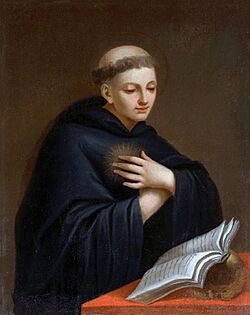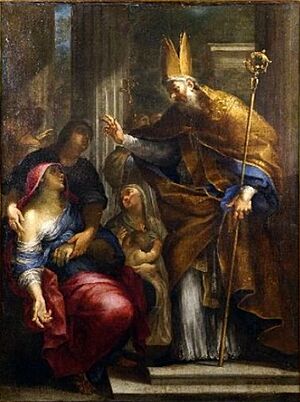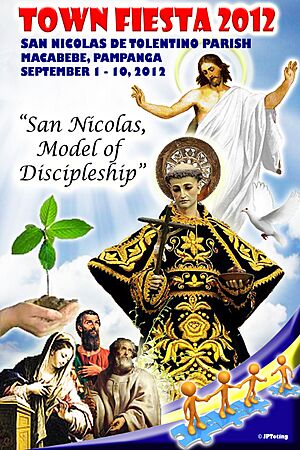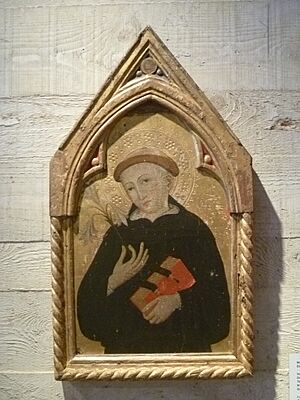Nicholas of Tolentino facts for kids
Quick facts for kids Saint Nicholas of Tolentino |
|
|---|---|
 |
|
| Born | 1245 Sant'Angelo in Pontano, Italy |
| Died | September 10, 1305 (aged 59–60) Tolentino, Italy |
| Venerated in | Roman Catholic Church |
| Canonized | June 5, 1446, Vatican by Pope Eugene IV |
| Major shrine | Basilica di San Nicola a Tolentino Tolentino, Italy |
| Feast | September 10 |
| Attributes | bird on a plate in the right hand and a crucifix on the other hand; basket of bread, ; lily or a crucifix garlanded with lilies; star above him or on his breast |
| Patronage | animals; babies; boatmen; dying people; mariners; holy souls; sailors; sick animals; souls in purgatory; watermen; La Aldea de San Nicolás, Spain; Barranquilla, Colombia; In the Philippines: Banton, Cabatuan, Capas, Guimbal, La Huerta, Cupang, Lambunao, Macabebe, Mariveles, Surigao City, Sinait, San Nicolas, Tibiao, Tobias Fornier, and the Dioceses of Cabanatuan, Mati, Surigao and Tandag. |
Nicholas of Tolentino (Latin: S. Nicolaus de Tolentino) was an Italian saint and mystic. He lived from about 1246 to September 10, 1305. People often call him the Patron of Holy Souls. This means many people pray to him to help the souls of people who have passed away. This is especially common during the Christian season of Lent and the month of November.
In many churches run by the Augustinian order, people gather every week. They pray to Saint Nicholas for those who are suffering. November 2nd, which is called All Souls' Day, is a very special day for those who honor Saint Nicholas of Tolentino.
Contents
Life of Saint Nicholas
Nicholas was born in 1245 in a place called Sant'Angelo in Pontano, Italy. His parents prayed at the shrine of St. Nicholas of Myra (the original Saint Nicholas) to have a child. That's how he got his name.
Nicholas became a friar (a type of religious brother) when he was 18 years old. Seven years later, he became a priest. He became well-known for his preaching and for listening to people's confessions. Around 1274, he was sent to Tolentino, a town close to where he was born.
Helping His Community
Tolentino was a difficult place at that time. Different groups, called the Guelphs and Ghibellines, were fighting for control of Italy. Nicholas worked mostly as a pastor, caring for the people in his community. He spent his time helping the poor and visiting people in prison.
People said he could heal the sick by praying over bread and then giving it to them. He would pray to Mary, the Mother of God, while doing this. Because of these stories, he became known as a wonderworker, someone who performs miracles.
Nicholas became ill towards the end of his life. He suffered a lot but continued his holy practices. He died in 1305. People immediately started asking for him to be made a saint. Pope Eugene IV officially made him a saint in 1446. His remains were found again in 1926 in Tolentino.
Early Life and Calling
Nicholas was a kind, gentle, and studious young man. At 16, he became an Augustinian novice. This meant he joined the Augustinian order to learn and prepare to become a friar. He was a student of a respected teacher named Blessed Angelus de Scarpetti.
He served as a friar in monasteries in places like Recanati and Macerata. In 1270, at the age of 25, he was ordained as a priest. Soon, he became famous for his powerful preaching and teachings. Nicholas had visions of angels telling him "to Tolentino". In 1274, he took this as a sign to move to that city. He lived there for the rest of his life.
Nicholas worked hard to improve morality and religion in the cities. These things were declining as cities grew in the late 1200s.
Saint Nicholas Bread
Because of his kind and gentle nature, his leaders asked him to feed the poor at the monastery gates every day. Sometimes, he was so generous with the monastery's food that the person in charge asked his superior to limit his giving.
Once, after a long fast, Nicholas felt very weak. He had a vision of the Blessed Virgin Mary and Saint Augustine. They told him to eat some bread that had a cross marked on it and was dipped in water. When he did, he immediately felt stronger.
He began giving these special rolls to people who were sick. He would pray to Mary while doing so, and often, people would get better. This is how the Augustinian tradition of blessing and giving out Saint Nicholas Bread began.
Peacemaker and Prayer
In Tolentino, Nicholas acted as a peacemaker. The city was divided by fighting between the Guelphs and Ghibellines. These groups supported the Pope and the Holy Roman Emperor in their struggle for control of Italy. Nicholas helped his community, supported the poor, and visited prisoners.
When he performed miracles or healed people, he always told them, "Say nothing of this." He explained that he was just God's tool.
During his life, Nicholas was said to have received visions. Some of these visions included images of Purgatory. His friends believed these visions came from his long periods of fasting. Praying for the souls in Purgatory was a very important part of his spiritual life. Because of this, Pope Leo XIII declared Nicholas the patron saint of the souls in Purgatory in 1884.
Legends of Saint Nicholas
Many stories and legends are told about Nicholas. One story says that the devil once beat him with a stick. This stick was then displayed in his church for many years.
In another tale, Nicholas, who was a vegetarian, was served a roasted bird. He made the sign of the cross over it, and the bird flew out a window!
Nine passengers on a ship that was sinking at sea once asked Nicholas for help. He appeared in the sky, wearing his black Augustinian robe. He glowed with golden light, held a lily in his left hand, and with his right hand, he calmed the storm.
It is also said that an appearance of the saint once saved the burning palace of the Doge of Venice. He did this by throwing a piece of blessed bread onto the flames. He was also reported to have brought back to life over one hundred dead children. This included several who had drowned together.
According to a writer from Peru named Antonio de la Calancha, Saint Nicholas of Tolentino helped the Spanish settle permanently in Potosí, Bolivia. This area has a very high altitude and harsh climate. The writer said that all children born to Spanish colonists there died during birth or soon after. This continued until a father dedicated his unborn child to Saint Nicholas of Tolentino. The colonist's son, born on Christmas Eve in 1598, survived and grew into a healthy adult. Many parents later followed this example and named their sons Nicolás.
Veneration and Feast Day

Nicholas was made a saint by Pope Eugene IV on June 5, 1446. Pope Eugene IV was also an Augustinian. Nicholas was the first Augustinian to be officially made a saint. At his canonization, Nicholas was credited with three hundred miracles. These included three instances of bringing people back to life.
The remains of Saint Nicholas are kept at the Shrine of Saint Nicholas. This shrine is located in the Basilica di San Nicola da Tolentino in the city of Tolentino, Italy.
He is especially honored as a helper for the souls in Purgatory. This is particularly true during Lent and the month of November. Many Augustinian churches hold weekly prayers to Saint Nicholas for these souls. November 2nd, All Souls' Day, is a very important day for those who honor Saint Nicholas of Tolentino.
His feast day is celebrated on September 10. Although his celebration was not kept in a major calendar revision in 1969, he is still recognized as an important saint in the Roman Catholic Church.
Many churches are named after him. These include San Nicolò da Tolentino in Venice, Italy, and churches in The Bronx, New York City, and Barranquilla, Colombia.
In Ireland, Augustinian churches often celebrate his feast day by giving out blessed bread. Sometimes, the bread even has his image on it. This tradition was strongest in churches in County Waterford.
Veneration in the Philippines
In the Philippines, many churches are dedicated to Saint Nicholas of Tolentino.
Banton Church
The 16th-century Church of San Nicolas de Tolentino in Banton, Romblon, was built in his honor. His feast day is celebrated there with the annual Biniray festival. This festival remembers how the island's Catholic people prayed to Saint Nicholas during Muslim raids in the 16th century.
Macabebe Church
In the province of Pampanga, there is a 440-year-old Augustinian church. It was founded in 1575 and built in his honor in Macabebe, Pampanga. The church's front has simple decorations. A small piece of the saint's remains is honored there every Tuesday after mass.
Cabanatuan Cathedral
In the province of Nueva Ecija, Saint Nicholas is honored as the main saint of the historic Cabanatuan Cathedral. This is where General Antonio Luna was killed in 1899. A small piece of his remains is shown to people from September 1st to September 10th each year.
Dimiao, Bohol
In Dimiao, Bohol, the feast of San Nicolas de Tolentino is also celebrated every September 10th. He is the patron saint of the local church, which was built between 1797 and 1815.
Cebu City
There is also the San Nicolas de Tolentino Parish Church in Cebu City, the capital of Cebu island. Built in 1584, it is one of the oldest churches in the country. The church was built years before the Cebu Diocese was even established in 1595. This area is also believed to be where Miguel López de Legazpi landed in 1565. The town of San Nicolas was very active during the Spanish period. It was important in the Revolution against Spain in 1898. It was also the birthplace of famous Cebuano musicians in the 20th century. The town later joined Cebu City in 1901.
Sinait, Ilocos Sur
The 16th-century church in Sinait, Ilocos Sur, is also dedicated to Saint Nicholas of Tolentino. In May 2021, Pope Francis gave this parish church the special title of minor basilica.
Iconography
Saint Nicholas of Tolentino is usually shown wearing the black robe of the Order of the Hermits of Saint Augustine. You might see a star above him or on his chest. He often holds a lily or a crucifix decorated with lilies in his hand. Sometimes, instead of a lily, he holds a small bottle filled with money or bread.




